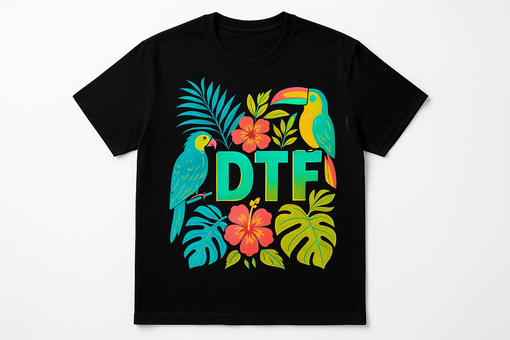
- Article tag: Brindes
Customizing t-shirts is a creative and effective way to promote a brand, create merchandise, uniforms, or unique pieces for events. At Grafipronto , we use different techniques to guarantee the best result depending on the design, fabric, and desired quantity.
In this guide, we explain the main printing techniques we use — DTF , digital transfer printing , and flex vinyl — and also present our premium and creative option: the Fullprint Unisex T-shirt , available exclusively online.
🎯 1. DTF (Direct-to-Film) Printing
How it works: The design is printed onto a special film with pigmented inks, coated with polyurethane powder, and then transferred to the fabric using heat and pressure.
✅ Advantages:
High color definition and very small details, ideal for intricate logos, photographic images with shadows, and white printing.
It works on almost all types of fabric (cotton, polyester, blends, and dark fabrics).
Good durability even after many washes.
Allows for small print runs or one-of-a-kind pieces with excellent quality.
⚠️ Disadvantages:
This process involves several steps, making production slower than simple stamping or vinyl printing.
Slight embossing on the fabric, perceptible to the touch in highly saturated designs.
💡 Ideal for: Merchandising, custom uniforms, intricate designs with lots of detail, and colorful clothing items.
🎯 2. Digital Printing with Transfer
How it works: The design is printed on special transfer paper using a Xerox digital laser printer with high-definition toner. Then, the transfer is applied to the t-shirt using a heat press , fixing the image onto the fabric.
✅ Advantages:
Very fast production, ideal for short deadlines and small print runs.
Vivid and crisp colors, excellent for simple images and logos.
It allows you to print photos, gradients, and fine details.
A good option for light-colored fabrics, especially white T-shirts .
⚠️ Disadvantages:
On black or very dark t-shirts, the result may vary (sometimes it loses contrast or saturation).
Less breathable in large areas due to the transfer film.
Lower durability compared to DTF in very common washes.
💡 Ideal for: White T-shirts for events, giveaways, small print runs, and quick on-the-spot customization.
🎯 3. Printing on Flex Vinyl (Cut or Print)
How it works: The vinyl is cut (for solid colors) or printed (for complex images) and then applied to the fabric with heat and pressure.
✅ Advantages:
Very high durability, especially for logos and cut-out images.
Possibility of special effects such as metallic, glitter, fluorescent or holographic .
Good resistance to washing.
⚠️ Disadvantages:
Less suitable for complex images with many details.
Thicker and more "plastic" to the touch.
More time-consuming for designs with many small elements.
💡 Ideal for: Names, numbers, simple logos, and pieces with special effects.
🆕 4. Unisex Fullprint T-Shirt
The Fullprint Unisex T-shirt is the ideal choice for those seeking unlimited customization. With this technology, the print covers the entire surface of the t-shirt — front, back, sleeves and collar — creating a completely integrated and professional look.
How it works: The custom design is printed in sections and directly onto the cotton or polyester fabric. After printing, the T-shirt is sewn on, resulting in a complete customization. The result is a vibrant, comfortable t-shirt with a completely soft feel.
✅ Advantages:
Full print (front and back) with no visible margins or cutouts.
Soft and natural to the touch, even in large prints.
Vibrant colors, resistant to washing, and easy to iron.
Production is possible in both 100% cotton and polyester , adapting to the desired purpose.
Ideal for creative designs, advertising visuals, and exclusive collections.
⚠️ Disadvantages:
Available only online , with a slightly longer production time as it is printed piece by piece and then assembled manually at the end.
💡 Ideal for: Custom brand creations, designer collections, creative events, and high-impact merchandising.
👉 View product in the online store
🏆 Quick Comparison
Technique
Speed of Production
Durability
Touch
Ideal For
DTF
Average
High
Smooth
Complex designs and varied fabrics
Digital Printing (Xerox + Transfer)
High
Average
Average
Quick customization and vibrant colors
Vinyl Flex
Reduced
High
Thick
Simple logos and special effects
Fullprint
Average
High
Very smooth
Complete prints and creative collections
👕 Grafipronto T-shirts
At Grafipronto we have a variety of t-shirt colors for customization, although black and white models are the most common in stock for immediate production in local stores .
Physical stores: models for men and women are available at Grafipronto in Shopping Cidade do Porto and at Grafipronto in El Corte Inglés Gaia .
Online: unisex models and the new Fullprint model, with full front and back printing, are available for direct customization on the website.
T-shirt characteristics:
190 g/m², 100% cotton jersey knit (shaded grey: 90% cotton / 10% viscose)
Carded cotton yarn
1x1 ribbed collar
Jersey reinforcement tape
Double stitching on the sleeves and bottom.
Tubular
Regular cut
Enzymatic treatment
🌱 Which one is more environmentally friendly?
DTF: Water-based inks with reduced waste, but the film and dust are plastic.
Digital Printing (Xerox + Transfer): Consumes little material and energy, but the transfer material is plastic that must be recycled.
Vinyl Flex: Less sustainable, but very durable, using PVC.
Fullprint: Solvent-free sublimation technology, with less environmental impact and no plastic waste.
📌 Conclusion
Each technique has its place. If you're looking for speed , digital printing with transfer is unbeatable. If you need unique details and versatility , DTF is the right choice. If your focus is on visual impact and durability , flexible vinyl is ideal. And if you want total creative freedom , Fullprint is the premium solution — available exclusively online at Grafipronto .
📞 Contact us or visit our stores and discover which technique and T-shirt model is best suited for your project.
Learn More